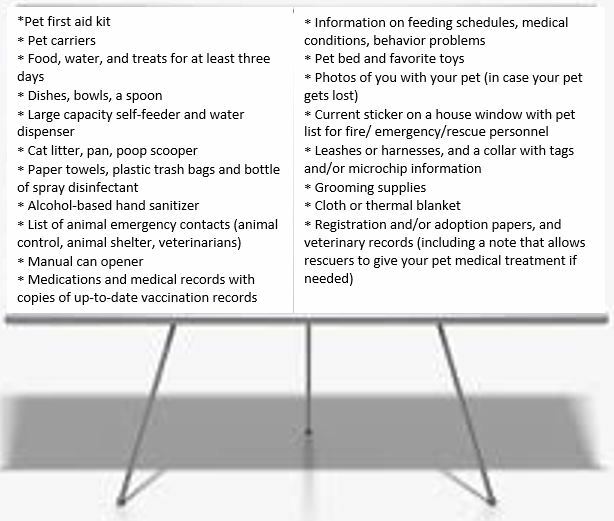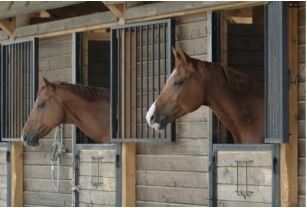
Pets and Livestock Preparedness
If you own pets, service animals, or livestock, it is very important to include them in your emergency preparedness. Our pets and animals are members of the family and they depend on us for their safety and wellbeing. If an emergency were to happen, it is important for you and your family, including your pets and animals, to be prepared. There are many things to consider before, during, and after an emergency to keep your animals safe.
Tuscaloosa Metro Animal Shelter is Tuscaloosa County's only animal shelter. They are funded by the City of Tuscaloosa, the City of Northport, and the Tuscaloosa County Commission. Should a disaster separate you from your pet, we recommend contacting Tuscaloosa Metro with a picture of your animal and other information.
For a list of Tuscaloosa County Veterinary Clinics and Animal Control numbers, Click Here.
Know a Safe Place to Take Your Pets in an Emergency
- Find out what places in your area can take care of your pets if you were to be evacuated.
- Contact your local animal shelter, humane society, veterinarian, or emergency management office to get information on caring for pets during an emergency.
- Contact hotels/motels outside of your area to check their policies on accepting pets and their restrictions on the number, size, and species. If they have a “no pet” policy, ask if it can be waived in an emergency situation.
- If you and your pets plan to use a hotel as your evacuation location during an emergency, make sure you call ahead for reservations as soon as you know that you may need to evacuate.
- Ask friends, relatives, or others outside the emergency area if they would be willing to watch your pets if you were to have to evacuate your home.
- After you have contacted hotels, motels, shelters, your veterinarian, and the other suggested places, make a list of all the “pet-friendly” facilities, including their 24-hour phone numbers.
- If you choose not to take shelter at your home during a tornado threat, look for local community shelters that accept pets. For a list in Tuscaloosa County, Click Here and look for shelters with a paw beside it. (Note: some have cage/crate restrictions)
- After an emergency, some people may not be able to return to their homes right away. Being out of your home for an extended period of time may mean that you need to board your pet. You should find out where the boarding facilities are in your area and be sure to research some outside your local area too in case the local facilities are closed due to the emergency or other reasons.
- When animals become lost during a disaster, they often end up at the Tuscaloosa Metro Animal Shelter. They can be reached at 205-752-9101.
- Note: Most American Red Cross shelters cannot accept pets because of health and safety concerns. Service animals that assist people with disabilities are allowed in the shelters.
Pet-Friendly Accommodations
If you find that you are having trouble finding “pet-friendly” accommodations, check out the websites below to assist you with your search in and out of the County should you need to leave your home. You may also check with local dog daycares and veterinarians for boarding options.
Gopetfriendly.com DogWonderful.com BringYourPet.com PetTravelCenter.com Pet-FriendlyHotels.net
Emergency Preparedness Precautions for Pets/Livestock
- Emergencies can happen with very little warning, which is why it is important that you and your pets and livestock are prepared in case of emergency.
- Include your pets in your family evacuation drills in the hopes that it will help them become comfortable with entering and traveling calmly in their carriers.
- You can train your pet to become comfortable with their carrier by placing their favorite toy or blanket inside the carrier. Make sure that you have a pet carrier that allows your pet to stand up and turn around inside.
- Make sure that your pets are wearing collars that have securely fastened and up-to-date identification tags. Other forms of identification to consider using are a dog license or microchip. (Tuscaloosa Metro Animal Shelter can check to see if your animal is chipped.)
- Your livestock should also have a few different forms of identification. Consider having your livestock microchipped or freeze marked.
- If an emergency happens and you feel your animals do not have proper forms of identification, try writing your name and phone number on their hooves. Use a livestock crayon to write your name, phone number, and address on them. Braiding into the horse’s mane an ID tag with your name, address, and phone number written on it is one more method. Talk to your veterinarian about other ways to have your animals marked for identification purposes.
- Have an evacuation plan for your animals, which should include a list of resources such as trucks, trailers, pasture, and/or feed. The plan should also list a person or persons (along with their phone numbers) who will be able to unlock gates and doors and make it easy for emergency workers to reach your animals.
Assemble a Pet Emergency Preparedness Kit!
Keep your pet’s essential supplies in sturdy containers that can be easily accessed and carried (e.g. a duffle bag). You should give this kit to whoever you are leaving your pets with during the evacuation.
Your pet emergency preparedness kit should include:

Assemble a Livestock Emergency Preparedness Kit!
Here is a list of things you should have available for your livestock and/or have in their emergency kits:
- Halters and lead straps/ropes
- Medical records and a list of necessary medicines
- At least three days of hay and/or other feed, water
- Livestock first aid kit
- Hoof care and grooming tools
- Water and feed buckets
- Registration papers and brand inspection cards

- Medications
- Fly spray
- Horse blanket
- Tack (in order to exercise your horse)
- Muck bucket, rake and shovel
- List of animal emergency contacts (animal control, animal shelter, veterinarians)
Protect Your Pet During an Emergency!
You should try not to leave your pets behind if you evacuate, but if you have absolutely no alternative but to leave your pets at home during an evacuation, there are some things you should know in order to prepare them and keep them safe. Remember, leaving your pet at home can place your animal in great danger. Danger can be in several forms. Wild Fire, Hurricane, Flooding, and a hazardous materials release are a few examples where you may have to take them with you. If you do leave them you may want to do the following:
- Animals have instincts about severe weather changes and will often isolate themselves if they are afraid. During these changes, to prevent your pets from running away, you should bring them inside immediately.
- Leave a two or three-day supply of dry food in a sturdy container that the pet cannot overturn. Water should also be left in a sturdy, no-spill container.
- If possible, open a faucet slightly and let water drip into a big container. Large dogs may be able to obtain water from a partially filled bathtub.
- If your dog wears a chain link collar, have a leather or nylon collar available for when you have to leave your dog alone for several days. Chain link collars can get caught on items around the house which can be dangerous and even deadly for your dog.
- Consider choosing easy-to-clean areas such as utility rooms, bathrooms, and basements as safe zones but try to give them enough room to move around and not have to stay in their own filth.
- In the event of flooding make sure they have access to high areas like hills or upstairs if a pet.
- Make sure any chemicals or potentially flammable materials are securely stored before leaving.
- Get a Rescue Alert Sticker or put up a sign saying animals inside or in the barn to first responders know there is an animal that may need help. The ASPCA has some for free on their website you can order and get mailed to you for free (you can sign up for them and ASPCA alerts by Clicking Here). Your local pet supply store may also sell them.
The “Buddy” Plan
- Create a “buddy plan” with nearby relatives, friends, or neighbors to help you with evacuating your animals if you are not home when the evacuation order is given.
- Include written permission for transport and care of your animals, and access to animal ID information and your animal emergency kit.
- If animals are stranded at your home during an emergency, contact local emergency management, law enforcement, or a community animal agency to arrange for evacuation assistance at your house.
- You should post somewhere in your barn area the number and types of animals you own, the location of your emergency kit, and your emergency contact information. This is important so that if someone has to evacuate your livestock, they will know how to help your animals and how to contact you.

Helping Pets Recover After an Emergency
Going through an emergency can be a very traumatic event for pets. Their behavior may change drastically after an emergency. Even normally quiet and friendly pets may become aggressive or defensive. You can help keep your pets safe after an emergency and return them to a life of normalcy.
- After the storm, your pets may be anxious and afraid. Try and comfort them. Speak calmly and take some time out to play with them. Doing so can help you in your recovery, as well. Scared animal may react in unusual ways by biting or scratching, spraying urine, defecating on floors.
- In the first few weeks after an emergency, leash your pets when they go outside and always maintain close contact with them.
- It is important to watch your animals closely and keep them under your direct control because fences and gates may have been damaged or destroyed.
- Familiar scents and landmarks may be altered and your pet may become confused and lost. Pets may become disoriented, particularly if an emergency has affected scent markers that normally allow them to find their home.
- It may be awhile before your pets are okay with being separated from you or being left home alone so take your pets with you when you can.
- When you let your pet go or play outside, be aware of other hazards such as downed power lines. Be aware of hazards at nose, paw or hoof level, particularly debris, spilled chemicals, and fertilizers and other substances that might not seem to be dangerous to humans.
